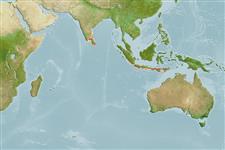分類 / Names
俗名 | 同種異名 | Catalog of Fishes(屬, 種) | ITIS | CoL | WoRMS | Cloffa
Teleostei >
Anguilliformes (Eels and morays)
鰻鱺目 (Eels and morays) >
Muraenidae (Moray eels)
鯙科 (Moray eels) > Muraeninae
Etymology: Diaphenchelys: Name from Greek 'diaphoros' meaning different and 'enchelys' for eel; referring to the anatomical characteristics and the unusual habitat (mud dweller) preference of the type species; pelonates: Name from Greek 'pelos' for mud and 'nates' for dweller, refers to its mud-dwelling habit; noun in apposition.
More on authors: McCosker & Randall.
Environment: milieu / climate zone / 深度上下限 / distribution range
生態學
海洋 居於水底的; 深度上下限 15 - 32 m (Ref. 75775).
Western Pacific: Indonesia.
大小 / 重量 / 年齡
成熟度: Lm ? range ? - ? cm
Max length : 46.5 cm TL 雄魚/尚未辨別雌雄; (Ref. 75775)
簡短描述
檢索表 | 型態特徵 | 形態測量圖
脊椎骨: 155. This species is small, elongate, slender, brown moray has white spots and vermiculations on the head behind the rictus and extends into the anterior trunk; pale margins posteriorly on fins; anus before midbody; length of preanal 2.5-2.6 in TL; gill opening depth 33-35 in TL; head 10-11 in TL; short snout, rear margin of orbit above middle or eye; jaws moderately long, not recurved; conical teeth, some needle-like; biserial maxillary teeth, those on outer row smaller and closely spaced; mostly uniserial mandibular teeth, outer row smaller and closely spaced; MVF 6/56/154 (Ref,. 75775).
Body shape (shape guide): eel-like.
Found on mud bottom with scattered rocks in 15-32 m (Ref. 90102).
Life cycle and mating behavior
成熟度 | 繁殖 | 產卵場 | 卵 | 孕卵數 | 仔魚
McCosker, J.E. and J.E. Randall, 2007. A new genus and species of mud-dwelling moray eel (Anguilliformes: Muraenidae) from Indonesia. Proc. Calif. Acad. Sci. 58(22):469-476. (Ref. 75775)
IUCN 瀕危狀態 (Ref. 130435: Version 2025-1)
人類使用
漁業: 沒有興趣
工具
特別的報告
下載 XML
網路資源
Estimates based on models
Phylogenetic diversity index (參考文獻
82804): PD
50 = 0.6250 [Uniqueness, from 0.5 = low to 2.0 = high].
Bayesian length-weight: a=0.00049 (0.00024 - 0.00099), b=3.26 (3.10 - 3.42), in cm total length, based on LWR estimates for this (Sub)family-body shape (Ref.
93245).
營養階層 (參考文獻
69278): 3.9 ±0.6 se; based on size and trophs of closest relatives
回復力 (參考文獻
120179): 中等的, 族群倍增時間最少 1.4 - 4.4年 (Preliminary K or Fecundity.).
Fishing Vulnerability (Ref.
59153): Moderate vulnerability (37 of 100).
🛈
